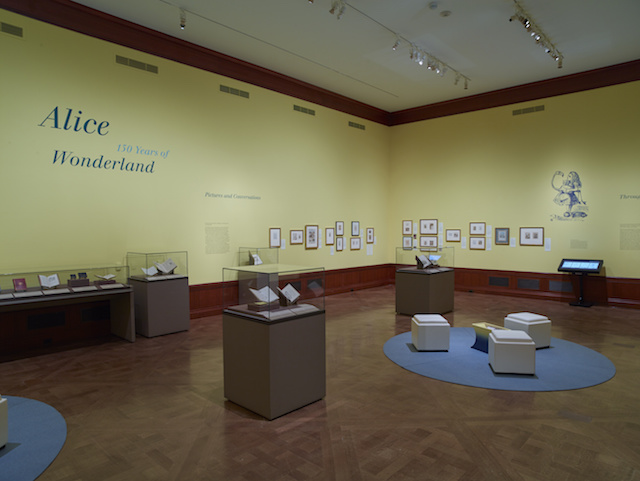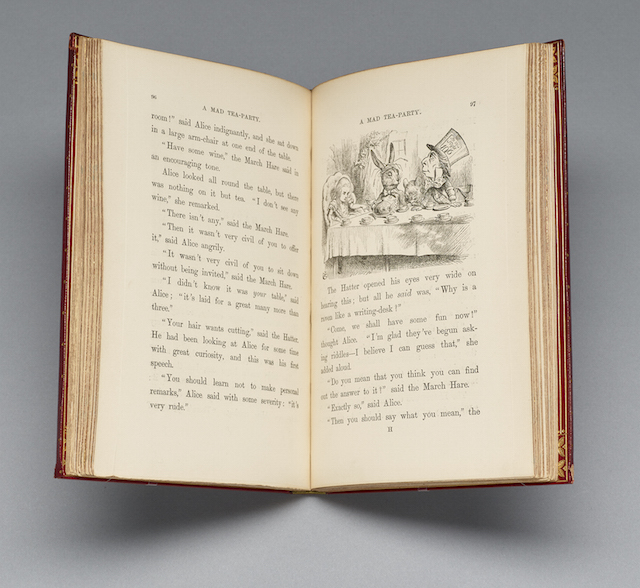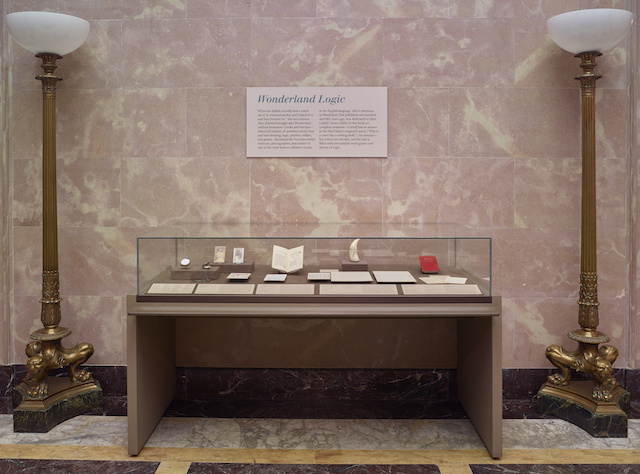
Photography by Graham S. Haber, 2015.
By Aditi Sriram
First printed in The Hindu Business Line on August 8, 2015.
The Morgan Library & Museum commands a quiet respect among New Yorkers for its impeccably curated literary exhibits. The museum was once the home and private library of John Pierpont Morgan and its exhibits evoke a certain coziness and intimacy.
Viewers are treated to an array of material, from maps to manuscripts, and are guided by the numerous artifacts on the walls set in long display cases. The exhibit rooms are not particularly large, but a tour of them will take over an hour because the exhibits are densely and cleverly configured. Currently on display is “Alice: 150 Years of Wonderland,” to commemorate the 150th anniversary of Lewis Carroll’s most famous book.

Photography by Graham S. Haber, 2015.
The exhibit starts in 1856 with a display case containing handwritten notes and page extracts from Carroll’s Doublets. Each explains a new, invented word game, and we start to discern a man infatuated by letters and numbers. Carroll—pen name for Charles Lutwidge Dodgson—initially wrote to entertain his ten siblings. At school, he not only wrote, but also published wacky poetry in a collection titled Useful and Instructive Poetry.
Professionally, he taught mathematics and logic at Christ Church, Oxford; this was a man who could flex both the left and right side of his brain. Working with these manuscripts, and Carroll’s paper toy theatre that conservators helped her display, curator Carolyn Vega establishes Carroll’s “interest in timekeeping and science in the natural world” before showing off the original Alice manuscript so that viewers could “start with a base understanding about Carroll—not something you walked off the street knowing.”
If the most successful books turn characters into real people, The Morgan inverts this dynamic to remind us that the fictionalized Alice was once a pre-pubescent who liked jewelry and travelled with a writing case.
Having set the tone for what to expect from Carroll—words, games, and humor—the exhibit begins at the beginning: how Dodgson became Carroll; his early poems and instinct for publishing; and his love of photography. It was not easy to be an amateur photographer in the 1820s, but Carroll could easily find landscapes and subjects on Oxford’s picturesque campus to practice his labor-intensive hobby. It was on one such mission that he wandered into the Christ Church Deanery, the garden belonging to the Dean of Christ Church. One Mr Liddell had been appointed just recently, in 1855, and Carroll spied a girl running around the garden he wished to photograph. The girl was Alice.
From the exhibits we learn that Alice was an imaginative and lively girl, as seen through her possessions, which include a ring, stationery, and letters she wrote to her father. If the most successful books turn characters into real people, The Morgan inverts this dynamic to remind us that the fictionalized Alice was once a pre-pubescent who liked jewelry and travelled with a writing case.
As they rowed across the river, Alice asked Carroll for a story. His response to this innocuous request re-routed children’s literature away from patronizing Victorian attitudes forever.
She also enjoyed adventures. On July 4, 1856, Alice and her two sisters went on a boat ride and picnic with Carroll and another Oxford professor. As they rowed across the river, Alice asked Carroll for a story. His response to this innocuous request re-routed children’s literature away from patronizing Victorian attitudes forever. Carroll did not just want to tell a story that afternoon. He wanted to recreate what he had tried to do for his siblings as a teenager, and for his students as a professor: create a world out of puzzles and give her the rest of her life to solve them.
For the next three months, Carroll worked on the narrative that had begun that day. He selected England’s most esteemed illustrator, John Tenniel, to collaborate with him, but the latter needed persuading. Undeterred, Carroll chose bright red for the cover, “the most attractive to childish eyes.” He rejected the working title, Alice’s Adventures Underground, because it sounded “too like a lesson book, in which instruction about mines would be administered in the form of a pill.” Carroll’s final poem in the sequel, “Through the Looking-Glass” is a double acrostic that spelled his muse’s full name: Alice Pleasance Liddell. At every point, Carroll took the sanctity of play absolutely seriously. The Morgan specifically mentions that “Alice and its sequel do not conclude with a moral … a breakthrough that is considered an important deviation in children’s literature. The stories exist to delight and inspire their readers (or listeners), not to be didactic.” Thanks to Carroll, books were no longer solely for adults or for children, and thanks to the Morgan, other exhibits there have showcased similar authors from Maurice Sendak to Beatrix Potter; from Babar the elephant, to the little prince from Asteroid B-612. Vega explains that “books that are not classifiable are complex works, making them more interesting to look at.”

Photography by Graham S. Haber, 2015.
The story of Alice is not complete without its publishing hiccups. When the first edition launched on June 27, 1865, Tenniel complained about the poor quality of the illustrations. Carroll ordered a complete reprint, shipping the first edition to America where neither Carroll nor Tenniel cared about readers’ reactions. The second edition was released in the UK in 1866, and has not been out of print since then.
A second perambulation of the exhibits reveal a curious parallel between two photographs on the wall. One is of Alice, her smiling gaze on something far away. Nearby, a second photograph is Carroll’s own portrait; he, too, is staring into another world. What are they both so busy looking at, while we look so fixedly at them?
